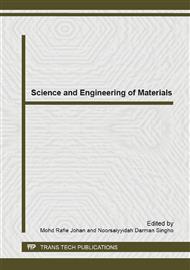p.192
p.198
p.204
p.209
p.217
p.224
p.228
p.235
p.240
A Non-Isothermal Thermo Gravimetric Kinetic Analysis of Malaysian Poultry-Processing-Dewatered-Sludge
Abstract:
Poultry processing dewatered sludge which consisting of trimmings, fat, feathers and liquid discharges from processing slaughtered chicken is typically land filled in specialized sites. It is a costly process to manage and if not handled according to stringent procedures can be harmful to the surrounding environment. The use of this waste material as an alternative fuel can be an effective solution, as it not only contributes as an energy source but also solves environmental issues related to poultry sludge disposal. Combustion, gasification and pyrolysis are efficient techniques of utilizing energy effectively from poultry sludge. The performances of mathematical models to predict the product gas quality is rely on characterization of feed materials as well as the reaction kinetics of their thermal degradation. The aim of this study is to determine selected physical and chemical properties of poultry sludge associated with thermochemical conversion. Thermogravimetric analyses were performed at heating rates of 10, 20, 30, and 40 K/min in an air (oxidizing) atmosphere. The parameters of the reaction kinetics such as activation energy and reaction order were obtained by the application of OzawaFlynn Wall and Vyazovkin kinetic models.
Info:
Periodical:
Pages:
217-223
Citation:
Online since:
June 2014
Keywords:
Price:
Сopyright:
© 2014 Trans Tech Publications Ltd. All Rights Reserved
Share:
Citation:


